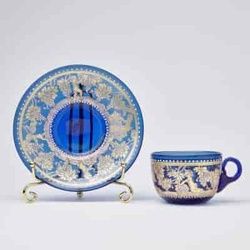
Венецианское стекло - значительная веха в истории стеклоделия. Первые упоминания о производстве стекла в Венецианской лагуне относятся к X веку. Становление культуры происходило на основе давних традиций поздней античности и творчества византийских мастеров.
Самый большой интерес представляет муранское стекло, украшенное эмалью и позолотой и относящееся к периоду приблизительно с 1450 по 1530 годы. По преданию, ничем, впрочем, не подтверждённому, начало росписи стекла эмалью в Венеции связывается с именем знаменитого мастера второй половины XV века Анджело Беровьеро, ученика одного из самых выдающихся химиков своего времени Паоло Годи ди Пергола. После 1530 года эмалированное стекло в Венеции выходит мало по малу из моды. Оно изготовляется ещё только для вывоза заграницу, преимущественно в Германию. В различных музеях встречается целый ряд бокалов, чаш и кувшинов, исполненных муранскими мастерами и украшенных гербами немецких фамилий. Иногда гербы эти исполнялись самими немецкими художниками, как, например, Гиршфогелем, Глокентоном и др. Во второй половине XV века было изобретено абсолютно бесцветное прозрачное стекло, знаменитый венецианский cristallo. Последнее название объясняется желанием подчеркнуть бесцветность нового стекла по сравнению с изготовлявшимся до тех пор стеклом зеленоватого оттенка или цветным стеклом. Это изобретение предание, опять-таки, приписывает уже упомянутому Анджело Беровьеро и его сыну Марино.
Уже в начале ХVI века венецианцы гравировали стекло алмазом, так называемым механическим способом. Химический способ гравирования был изобретен только во второй половине ХVII века и состоит в следующем: всю поверхность предмета покрывают мастикой, состоящей из смеси воска с терпентином, затем на мастике выцарапывается рисунок, который обнажает те части стекла, которые должны быть вытравлены. Подготовленный таким образом предмет подвергается действию соответствующей кислоты, которая проедает стекло по обнаженным линиям рисунка, после чего мастика смывается.







